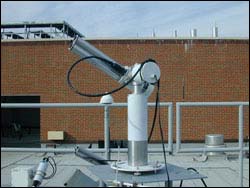AERONET Mission Follow Up: Finding an Instrument’s Place Under the Sun

Sun Photometer Pointing at Sun and Taking Measurements -- A Sun photometer measures the intensity of sunlight arriving directly from the Sun. They are pointed directly at the Sun and measure direct sunlight. Since haze and aerosols block some direct sunlight, a Sun photometer is an ideal instrument for measuring haze. Credit: NASA
East Africa now has some new NASA technology to monitor the tiny particles in the air known as aerosols.
Dr. Michael King, Senior Project Scientist of NASA’s Earth Observing System at NASA’s Goddard Space Flight Center (GSFC), Greenbelt, Md., led a group of NASA scientists that traveled through Kenya, Tanzania, Uganda and Eritrea from February 26 to March 18, 2005, to find locations to place a number of NASA’s AErosol RObotic NETwork (AERONET) sunphotometer.
A sunphotometer is an instrument which measures the intensity of the Sun’s light, when pointed directly at the Sun. Any aerosols and gases (haze) between the Sun and the photometer tend to decrease the Sun’s intensity. A hazy sky would read a lower intensity of sunlight and give a lower voltage reading on the photometer. A clear blue sky would result in a greater intensity and a higher voltage reading.
Michael King was accompanied by Dr. Charles Gatebe, Assistant Research Scientist at the University of Maryland-Baltimore County’s (UMBC) Goddard Earth Science and Technology Center (GEST); Brent Holben, GSFC Project Scientist for AERONET; and Dr. Ali Omar, scientist from NASA Langley Research Center, Hampton, Va. They traveled throughout East Africa to find the perfect location for the AERONET instruments. The AERONET sunphotometers will check to make sure satellite measurements are accurate, and add to the knowledge of tiny aerosol particles’ effects on climate change.
They visited various parks and nature sites, including Mbita Point Research and Training Centre on Lake Victoria, Nairobi National Park, Masawa, Eritrea on the Red Sea and the western Rift Valley in Uganda.
King’s team met with science and technology officials and lectured at universities, high schools and community organizations about the AERONET project and NASA’s interest in East Africa. Some of those institutions they spoke at included: University of Nairobi; Egerton Universtity, Kenya; Kiriti Secondary School, Nyeri; and Tanzania Meteorological Agency; Makerere University; Eritrea Ministry of Education.
At the conclusion of the mission, several ideal sites for the AERONET sunphotometers in East Africa were identified in Malindi, San Marco; Nairobi National Park, Nairobi and Mbita Lake Point, Lake Victoria. Makerere University Biological Field Station at Kibale National Park, Uganda and Eritrea Polytechnic University, Asmara, Eritrea. These AERONET sites will help fill in current gaps of missing information about aerosols.
NASA’s Earth Observatory Web site is full of information available and useful to people throughout Africa, and all over the world. To access the web site go to: earthobservatory.nasa.gov . NASA scientists are soon to follow up this trip and continue to make certain that the AERONET instruments will be placed in the locations that best fit its requirements to observe areas sufficiently.
Media Contact
All latest news from the category: Ecology, The Environment and Conservation
This complex theme deals primarily with interactions between organisms and the environmental factors that impact them, but to a greater extent between individual inanimate environmental factors.
innovations-report offers informative reports and articles on topics such as climate protection, landscape conservation, ecological systems, wildlife and nature parks and ecosystem efficiency and balance.
Newest articles

Superradiant atoms could push the boundaries of how precisely time can be measured
Superradiant atoms can help us measure time more precisely than ever. In a new study, researchers from the University of Copenhagen present a new method for measuring the time interval,…

Ion thermoelectric conversion devices for near room temperature
The electrode sheet of the thermoelectric device consists of ionic hydrogel, which is sandwiched between the electrodes to form, and the Prussian blue on the electrode undergoes a redox reaction…

Zap Energy achieves 37-million-degree temperatures in a compact device
New publication reports record electron temperatures for a small-scale, sheared-flow-stabilized Z-pinch fusion device. In the nine decades since humans first produced fusion reactions, only a few fusion technologies have demonstrated…





















